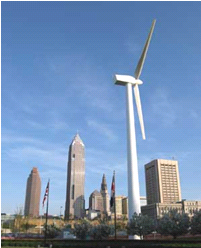Press Release
Tagged In: Energy Efficiency, Fossil Fuels, Green Energy, Natural Resources
All of the Above: Governor Kasich’s Energy Plan Ambitious for Fossil Fuels and Clean Energy Alike
Ohio Environmental Council, January 24, 2014
 Proposal will reform regulations on traditional fossil fuels while creating incentives for energy efficiency as well as renewable and advanced energy technologies
Proposal will reform regulations on traditional fossil fuels while creating incentives for energy efficiency as well as renewable and advanced energy technologies
Columbus, OH – Ohio Gov. John Kasich, today, unveiled his much-anticipated 21st Century Energy Policy. The Governor’s proposal contains multiple policy proposals-from strengthening regulations for oil and natural gas, to workforce development initiatives, to several incentives for energy efficiency and renewable and advanced technologies.
“True to his word, Gov. Kasich has proposed an ambitious plan that promotes all forms of energy, black and green, alike,” commented Jack Shaner, Deputy Director for the Ohio Environmental Council.
“We are cautiously optimistic and are eager to review the actual language of the proposal. Bottom line, we look forward to working with the Kasich team to develop Ohio’s energy resources, especially energy efficiency, waste energy, and renewable energy.”
Advocates and energy stakeholders have been eagerly awaiting the Governor’s energy plan since last September, when the stakeholders from across the world gathered at “The Ohio Governor’s 21st Century Energy & Economic Summit.”
The Summit provided for a variety of panel discussions on utility and energy policy in Ohio. Attendees heard from many of Ohio’s leading energy voices including the top executives at Ohio’s investor-owned electric providers, First Energy, American Electric Power, Duke Energy, and Dayton Power & Light.
The resulting legislative proposal revealed today touches on most of the issues discussed at the summit, including provisions that:
- expand customer choice for renewable energy;
- introduce smart grid and smart metering to Ohio’s electric transmission system;
- address interconnection issues for renewable energy and natural gas transmission;
- shore up regulations on the oil and natural gas industry;
- create infrastructure and incentives for compressed natural gas vehicles and;
- incent cogeneration as an electric-generation resource.
“The Governor’s Energy plan is quite comprehensive-pushing, simultaneously, for more fossil fuels and more clean energy,” stated Brian Kaiser, Director of Green Jobs and Innovation for the Ohio Environmental Council. “We commend the Governor for stating that he’s preserving the goals of Ohio’s renewable energy and energy efficiency standards. However, the devil is in the details. We’ll be reviewing the bill closely to ensure that the integrity of these standards remain intact.”
Since Senate Bill 221 was enacted in 2008, creating Ohio’s Renewable Portfolio Standard (RPS) and Energy Efficiency Resource Standard (EERS), Ohio has seen a boom in clean energy and energy efficiency jobs due to its renewable energy and energy efficiency standards.
According to the law, by 2025, electric utilities located in Ohio must supply 25% of their electricity from advanced energy sources. At least half of the 25% must come from renewable sources (including a 0.5% solar carve-out).
At least half of the power generated must come from facilities located in Ohio. Additionally, electric utilities are required to implement energy efficiency and peak demand reduction programs that achieve a cumulative energy savings of 22% by 2025.
The legislation also contains several provisions to encourage more waste energy recovery (WER) and combined heat and power (CHP). Recently, Ohio was ranked 5th in the nation by the U.S. Department of Energy for the potential of cogeneration to provide several thousands of megawatts of electricity for Ohio businesses and residences. However, Ohio is 43rd in the nation for implementation of these technologies.
“These are two extremely-underutilized technologies that are a win-win for Ohio manufacturers in terms of job creation and the environment,” commented Trish Lanahan, Director of Clean Energy Campaigns for the Ohio Environmental Council. “The Governor’s Energy policy will potentially take a big step forward in developing these types of clean energy projects.”
The bill also includes provisions addressing the potential shale gas boom in Ohio. The Governor’s plan combines new taxes, fees, and regulations on shale drillers. The Governor touted the shale provisions as a “modernization” of ODNR and Ohio EPA rules on drilling impacts.
But the plan seems to ask drillers to meet a few strengthened regulatory protections, while making permitting quicker and simpler.
“The regulatory improvements are sorely needed, especially as it concerns disposal of waste product into underground injection wells.” said Trent Dougherty, OEC Director of Legal Affairs. “Yet, we cannot continue to permit industrial-scale fracking without local government and public input.”
The increased fracking taxes, however, are to fund an income tax reduction – and do not appear to support additional oil and gas inspectors and industry oversight.
“Increases in fees on drillers must be dedicated to cover the currently unfunded mandate put on local governments to protect their citizens from risks,” Dougherty added. “More fees must mean more first responders, better infrastructure, and more inspections-not just shifting revenue and shifting burdens.”
In sum, while the Governor’s plan appears to contain several positive steps towards further developing clean energy resources and expanding customer choice in clean energy options, the proposal also contains provisions that prop up coal.
Advocates caution that focusing incentives and investments too much on mature technologies and resources that are facing stepped-up environmental controls will create missed opportunities for growing clean energy industries.
-end-